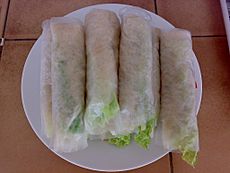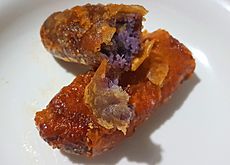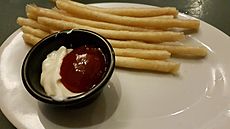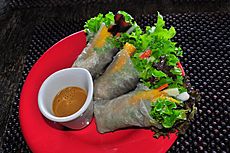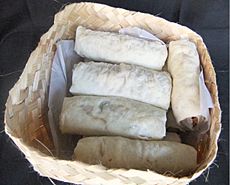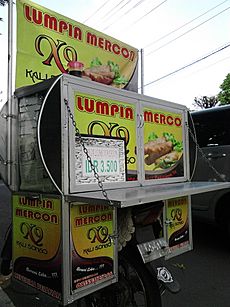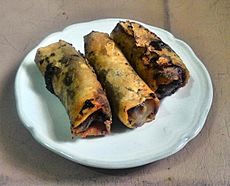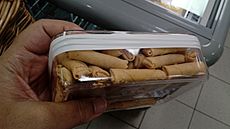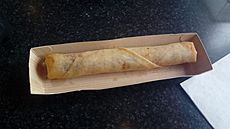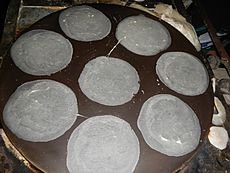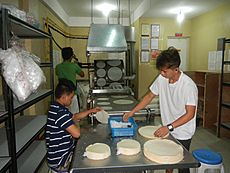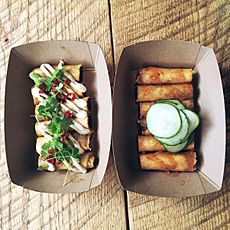Lumpia facts for kids
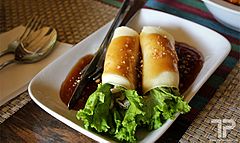 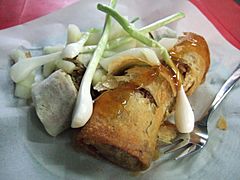
Top: Fresh lumpiang ubod made with heart of palm from the Philippines
Bottom: Fried and unfried lumpia Semarang from Indonesia |
|
| Alternative names | Loempia, loenpia, ngohyong |
|---|---|
| Course | Main course or snack |
| Place of origin | China |
| Created by | Chinese Filipinos and Chinese Indonesians |
| Serving temperature | hot or room temperature |
| Main ingredients | Wrapper, meat, vegetables |
| Variations | Fried or fresh |
Lumpia are tasty spring rolls popular in the Philippines and Indonesia. They are made with a thin, crispy wrapper, like paper or a thin pancake, called a "lumpia wrapper". This wrapper holds yummy savory or sweet fillings. Lumpia is often served as a starter or a snack. You can enjoy it deep fried (crispy) or fresh (soft). Lumpia recipes came from the popiah spring rolls of China, which were first made around the 1600s.
In the Philippines, lumpia is a very common dish at parties and celebrations. In Indonesia, it's a favorite snack, often sold by street vendors.
In the Netherlands and Belgium, lumpia is spelled loempia. This old spelling from Indonesia is now the general word for "spring roll" in Dutch. There's also a Vietnamese lumpia that uses a thinner wrapper, but it's still similar to other spring rolls.
Contents
What's in a Name?
The name lumpia (sometimes lunpia) comes from the Hokkien language. The word lun means "wet," "moist," or "soft." The word pia means "cake" or "pastry." So, lun-pia means "soft cake." In Mandarin, it's called rùnbǐng or báobǐng.
In nearby Malaysia and Singapore, lumpia is known as popiah. This name also comes from a Chinese dialect and means "thin wafer."
Different Kinds of Lumpia
Lumpia in the Philippines
Lumpia arrived in the Philippines a long time ago, brought by Chinese traders between 900 and 1565 AD. The name comes from the Hokkien language. Over time, lumpia became a big part of Philippine cooking. People across the islands make it with different fillings, using local foods and ideas from Spanish, Chinese, and American cooking.
Filipino lumpia often uses a very thin wrapper made from just flour, water, and salt. Traditionally, they were long and thin, like cigars. Today, they come in many shapes and sizes. The thin wrapper makes them crispy and light when fried. They are usually dipped in sweet and sour sauce (called agre dulce), vinegar sauces, banana ketchup, or sweet chili sauce.
Fresh lumpia, however, has a thicker, more crêpe-like wrapper because it includes eggs. These are closer to the original Chinese versions and were once made with rice flour, making them chewier. Both fried and fresh lumpia are very popular at Filipino parties and holidays like Christmas.
Filipino lumpia also has a special sweet version called turón. These lumpia are cooked with a sweet sugar glaze, sprinkled with sugar, or drizzled with coconut caramel (latík), syrup, or honey. Turón usually has ripe saba bananas and jackfruit inside. But you can find them with many other sweet fillings, like sweet potato or purple yam (ube).
Daral
Daral is another sweet lumpia from the Tausūg people in Mindanao. Its wrapper is made from unsweetened glutinous rice and coconut milk. It's filled with sweetened coconut meat.
Dinamita
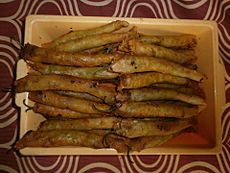
Dinamita, or "dynamite lumpia," is a deep-fried lumpia with a whole chili pepper inside. The pepper is wrapped in a thin egg wrapper. The filling usually includes ground beef or pork, cheese, and spices. But it can also have other things like bacon or shredded chicken. People often eat it as a starter or with beer.
Lumpiang Gulay
Lumpiang gulay means "vegetable spring roll." It usually has different chopped vegetables and a little bit of pork or shrimp. The vegetables can change a lot, sometimes even including tomatoes. This is a fried lumpia. It's not always vegetarian, but you can make vegetarian versions easily.
Lumpiang Hubád
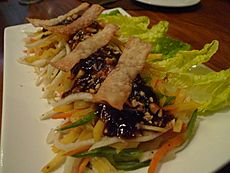
Lumpiang hubád means "naked spring roll." It's basically fresh lumpia served without the wrapper. Even though it doesn't have a wrapper, it's a different way to enjoy the traditional fresh lumpia fillings.
Lumpiang Keso
Lumpiang keso, also called "cheese lumpia" or "cheese sticks," is a deep-fried lumpia filled with a slice of cheese, often cheddar. It's usually served with a dipping sauce made of banana ketchup and mayonnaise.
Lumpiang Sariwà
Lumpiang sariwà means "fresh spring roll." It has chopped vegetables and/or cooked meat or seafood, often with jicama (singkamás) to make it fuller. It's wrapped in a lettuce leaf and a yellowish egg crêpe. The sauce is made from chicken or pork broth, peanuts, and fresh garlic. This kind is not fried and is usually about 5 cm wide and 15 cm long. It comes from the original Chinese popiah.
Lumpiang Shanghai
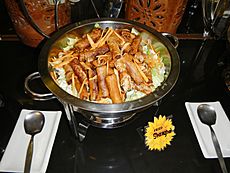
Lumpiang Shanghai is thought to be the most common type of lumpia, especially at Filipino gatherings. It's usually filled with cooked ground pork, chopped onion, carrots, and spices. Sometimes, beaten egg is added to hold it together. There are many versions with other ingredients like green peas or raisins. Lumpiang Shanghai is often served with sweet and sour sauce, but ketchup (tomato or banana) and vinegar are also popular. This type is usually smaller than other lumpia. Even with its name, it didn't actually come from Shanghai or China.
Lumpiang Togue
This lumpiang gulay version is mostly filled with bean sprouts (togue) and other vegetables like string beans and carrots. Small pieces of meat, seafood, or tofu can be added. It's a fried lumpia.
Lumpiang Ubód
Lumpiang ubód is made with shredded ubód (heart of the coconut tree) as the main ingredient. You can have them fried or as lumpiang sariwà (fresh). It comes from Silay, Negros Occidental.
Turón
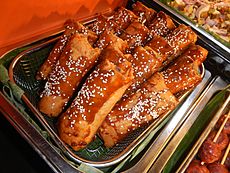
Turón, also known as lumpiang saging or banana rolls, is a golden-brown snack. It's usually made with sliced saba bananas and jackfruit or cheese inside a lumpia wrapper, sprinkled with brown sugar, and deep-fried. It's sometimes served with ice cream or pancake syrup. This snack is sold on the streets in many cities. Different versions use other ingredients like mango, sweet potato, or mashed purple yam.
Lumpia in Indonesia
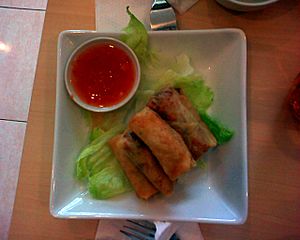
Chinese cooking has greatly influenced Indonesian cuisine, and lumpia is one example. Across Indonesia, spring rolls are generally called lumpia.
In Indonesia, lumpia is linked to Chinese Indonesian cuisine. It's often found in cities where many Chinese Indonesians live. While there are local versions, the most famous is Lumpia Semarang. This one comes in both fried and unfried types. Indonesian lumpia versions are usually named after the city where they started.
Unlike in the Philippines, Indonesian lumpia rarely uses minced pork. This is because many people in Indonesia are Muslim. So, popular fillings are usually chicken, shrimp, egg, and vegetables. Indonesian lumpia often has seasoned chopped bamboo shoots with minced chicken or prawns. It's served with fresh baby shallots or leeks in a sweet sauce made from fermented soy (tauco). Besides being made at home, lumpia is also sold as street food by vendors or in food stalls. Indonesians love spicy food, so hot sambal chili sauce or fresh bird's eye chilies are often added as a dipping sauce.
Lumpia Semarang
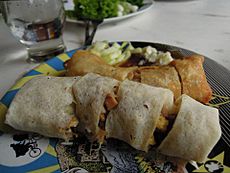
Named after Semarang, a city in Central Java, lumpia Semarang is perhaps the most popular lumpia in Indonesia. It's a famous food gift or souvenir for visitors to Semarang. Originally made by Chinese immigrants, this lumpia is filled with bamboo shoots, dried shrimp, chicken, and/or prawns. It's served with a sweet chili sauce. Lumpia Semarang can be deep-fried or unfried, as the filling is already cooked.
Lumpia Jakarta
Named after Jakarta, Indonesia's capital city, this lumpia is usually deep-fried and sold as a fritter snack. Unlike Semarang lumpia, Jakarta lumpia uses jicama (bengkuang) and is served with spicy peanut sauce.
Lumpia Bogor
Named after Bogor in West Java, this lumpia's filling is similar to Jakarta lumpia, using jicama, tofu, and dried shrimp. Unlike other fried versions, Bogor lumpia is usually grilled on a hot iron. This gives it a special smell. Also, Bogor lumpia is often shaped like a large, rectangular pillow.
Lumpia Bandung
Named after Bandung in West Java, this is a type of lumpia basah (fresh, unfried lumpia). However, it's not rolled like a spring roll. Instead, the wrapper is spread out, topped with fillings, and then folded into a square, like an envelope. The filling uses shredded jicama, beansprouts, scallion, garlic, chili, and scrambled egg, with a palm sugar sauce.
Lumpia Surabaya
Named after Surabaya in East Java, this lumpia uses similar ingredients to Semarang lumpia but is less sweet. Lumpia Surabaya might have bamboo shoots, corn, or slices of sausages as fillings. It's served with sambal chili sauce and fermented soybean paste (tauco).
Lumpia Yogyakarta
Even though Yogyakarta is close to Semarang, it has its own type of lumpia. Yogya lumpia usually contains jicama, bean sprouts, carrots, and minced chicken. Sometimes, boiled quail eggs and glass noodles are added. Yogya lumpia is often served with pickles, chilies, and crushed garlic and jicama on top. The garlic and pickles help to balance the oily taste of the deep-fried lumpia.
Lumpia Goreng
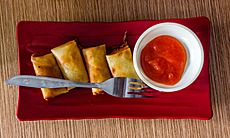
Lumpia goreng is a simple fried spring roll filled with vegetables like chopped carrots and shredded cabbage. Sometimes, mushrooms are added. While usually just vegetables, these fried spring rolls can also have minced beef, chicken, or prawns. There's also a common, cheap version sold as part of mixed fritters (gorengan). These have simple fillings like rice vermicelli with carrots and cabbage. They are usually eaten with fresh bird's eye chili peppers.
Lumpia Basah
This means "wet spring roll" or "fresh spring roll," because it's not fried. It's similar to Vietnamese spring rolls with bean sprouts, carrots, shrimp, and/or chicken. It's served with a sweet tauco (salted soybeans) sauce.
Lumpia Ayam
This popular Indonesian appetizer is chicken lumpia. Its filling includes shredded chicken, sliced carrot, onion, and garlic, seasoned with sugar, salt, and pepper. In Yogyakarta, there's a famous chicken lumpia called Lumpia Mutiara.
Lumpia Sayur
Vegetarian lumpia, usually filled with glass noodles, shredded cabbage, lettuce, shredded carrots, minced garlic, and celery. It's seasoned with soy sauce and sweet chili sauce. Most of the cheaper lumpia sold as part of Indonesian gorengan (fritters) are lumpia sayur (vegetable lumpia). They only contain bits of carrots and rice glass noodles.
Lumpia Mercon
The name lumpia mercon (meaning "firecracker lumpia") tells you this lumpia is extra hot and spicy. It's filled with slices of cabe rawit or bird's eye chili, a very spicy type of chili. This lumpia shows how much Indonesians love super hot and spicy food.
Lumpia Mini
This is a small, bite-sized lumpia snack. It uses the same wrapper as regular lumpia but is filled only with abon (beef floss) or ebi (dried prawn floss).
Lumpia Tahu
Another vegetarian lumpia in Indonesia is lumpia tahu or tofu lumpia. It's filled with tofu and diced carrot, lightly seasoned, and deep-fried. It's usually smaller than regular lumpia and eaten as a snack. Sometimes, beaten egg and chopped scallion are added to the filling.
Piscok
Piscok is short for pisang cokelat, which means "banana chocolate" in Indonesian. It's a sweet snack made of banana pieces with chocolate syrup, wrapped inside lumpia skin, and deep fried. Piscok is often called "choco banana spring rolls." It's like a mix of two other Indonesian favorites: fried banana (pisang goreng) and lumpia. The type of banana used is usually pisang uli or pisang kepok. Piscok is very similar to Filipino turon, but the Indonesian version must have chocolate.
Sumpia
Sumpia is a much smaller and drier lumpia. It has a similar beef or prawn floss filling. It's about the size of a human finger. In Indonesia, the most common filling for sumpia is ebi (dried shrimp floss), spiced with coriander, lemon leaf, garlic, and shallot. These tiny lumpia are deep fried in lots of palm oil until they are golden brown and crispy. Sumpia is very crunchy and dry, often eaten as a savory snack.
Lumpia in the Netherlands
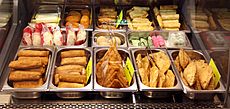
In the Netherlands, lumpia is called loempia, using an old Indonesian spelling. It came to the Netherlands because of their historical ties with Indonesia. In the Netherlands, loempia is described as a large Indonesian version of Chinese spring rolls. It's filled with minced meat, bean sprouts, and cabbage leaves, and flavored with soy sauce, garlic, and green onion. Loempia is a popular snack sold in Dutch snack bars.
Loempidel
The loempidel is a new type of loempia introduced in 2019. Its name is a mix of "loempia" and "frikandel" (a type of sausage). This snack has a frikandel sausage with sweet sauce, wrapped in a thin phyllo pastry.
Lumpia Wrappers
How Filipino Wrappers Are Made
Filipino lumpia wrappers come in two main types. The most common one, used for fried lumpia, is made from just flour, water, salt, and sometimes cornstarch. This wrapper is super thin, much thinner than other spring roll wrappers. The ingredients are mixed into a wet dough. Then, a ball of dough is smeared onto a hot, flat metal plate greased with oil. A very thin circle of dough sticks to the pan and cooks quickly. It's cooked for a few seconds, then taken off and left to dry.
For "fresh" (not fried) lumpia, the wrappers usually have egg added to the other ingredients. This makes them like a thin egg crêpe. They are still thinner than other spring roll wrappers but thicker and softer than the ones made without egg.
Today, many Filipino lumpia wrappers are made by machines. These machines are similar to those used for other spring roll wrappers, but they use a different recipe to make the wrappers thinner.
Some wrappers are made without eggs for vegan versions. These are just flour, salt, and water, which makes a thinner, see-through wrapper. They are sealed with water instead of egg.
Why Lumpia is So Popular
Lumpia is so loved that you can find at least one type at almost any Filipino or Indonesian celebration. Even though it came from China, in the United States, lumpia is known as a Filipino dish. In Europe, especially in the Netherlands, it's known as an Indonesian dish. This is because of their shared history with these countries. The unique taste and how easy it is to make (especially the Shanghai type) have made lumpia a main dish on menus in many Filipino restaurants around the world.
See also
In Spanish: Lumpiá para niños


